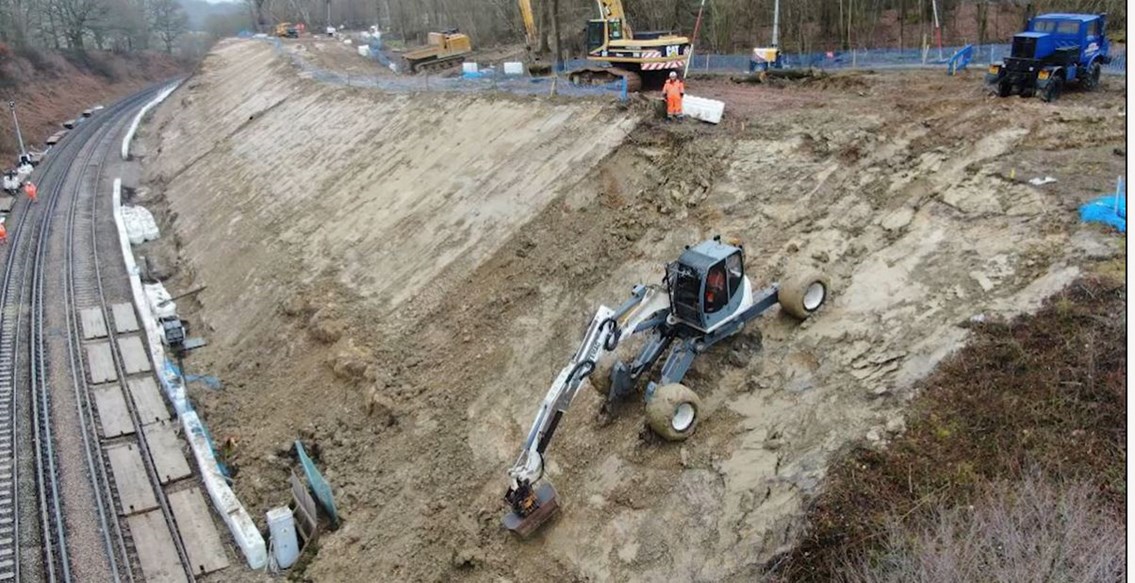Monday 22 Feb 2021
Tonbridge to Robertsbridge railway reopens after landslip repairs completed
- Region & Route:
- Southern: Kent
Network Rail has thanked passengers for their patience after completing work to repair a landslip at High Brooms and preventative work at several other vulnerable sites which caused the closure of the railway between Tonbridge in Kent and Robertsbridge in East Sussex.
The landslip at High Brooms occurred in the early hours of Monday, 1 February and was detected by remote sensors, prompting work to protect the railway along a 150m stretch of cutting.
The line was reopened on Saturday, 20 February following a full-scale repair working 10m into the surrounding hills.
At the same time work was taking place nearby to repair a potential landslip at the southern end of Wadhurst Tunnel.
This work was accelerated to be completed ahead of its planned completion date to minimise disruption to passengers caused by the closure of the Hastings Line in the Tunbridge Wells section.
Fiona Taylor, Network Rail Route Director for Kent, said: “I’m really grateful to passengers and our lineside neighbours for their patience during these works. It is absolutely essential that our railway is safe to travel on and the work we’ve done will help to improve the resilience of this line for years to come. By working smartly, we have been able to accelerate some of the repairs needed on a nearby site at Wadhurst Tunnel. I am pleased that we were able to fully reopen the London to Hastings line on Saturday.
“This line, and several others across the Southern region, are unfortunately suffering from landslips caused by the higher than average rainfall during this and several recent winters. This is driven by the changes we’re seeing in our climate. We aim to detect these failures in advance, repairing them rapidly and safely as part of our plans to make our railway resilient for the future.”
A previous speed limit which was in place on the line has also been lifted allowing faster journeys for passengers. Soil nailing will now be completed at the site, with the rail line open, to finalise the works.
Southeastern’s Train Services Director, Scott Brightwell, said: “There is never an ideal time to close the railway but this work by Network Rail is essential to ensure that this stretch of track is back open will allow passengers journeys on the Hastings line to continue uninterrupted. I’d like to thank passengers for bearing with us while these works were carried out.”
The slippage at High Brooms was picked up by remote sensors which had been in place following two previous smaller slippages in the same area. Engineers were immediately despatched to investigate and found that there was a risk to the track and trains so took the decision to close the line.
The permanent fix along approximately 150 metres of the 160-year-old cutting included re-grading it (making it less steep), soil nailing and placing netting over the top to ensure no more slippage occurs. Over 5000 tonnes of spoil was removed from the site to make the repair.
Notes to Editors
- A short film of the works has been produced and can be found here: https://network-rail.wistia.com/medias/48rx07ah14 or at Network Rail South East's Twitter account @NetworkRailSE
- The landslip is thought to have occurred because of excessive rain experienced in the area which has seen more than twice the average monthly rainfall in January, on the back of a very wet December.
- The cutting at High Brooms is very steep, as the Victorian contractors did not want to buy more land to allow a shallower cut, and their knowledge of soil mechanics was rudimentary. It is also cut through a seam of Wadhurst Clay, which is very poor for constructing earthworks as it absorbs water and does not drain freely.
- The cutting was regraded from 40% to 32% to help its strength, but for comparison, a modern railway, such as HS1, or motorway, will having cuttings graded to 18%. It would not be possible to regrade our existing lines to that level, as there is not enough land available to do it.
For more information on landslips and how Network Rail tackles them please visit our dedicated webpage: https://www.networkrail.co.uk/running-the-railway/looking-after-the-railway/delays-explained/landslips/
Contact information
Passengers / community members
Network Rail national helpline
03457 11 41 41
Latest travel advice
Please visit National Rail Enquiries
Journalists
Scott Wilson
Media Manager
Network Rail
07395 389658
scott.wilson@networkrail.co.uk
About Network Rail
We own, operate and develop Britain's railway infrastructure; that's 20,000 miles of track, 30,000 bridges, tunnels and viaducts and the thousands of signals, level crossings and stations. We run 20 of the UK's largest stations while all the others, over 2,500, are run by the country's train operating companies.
Usually, there are almost five million journeys made in the UK and over 600 freight trains run on the network. People depend on Britain's railway for their daily commute, to visit friends and loved ones and to get them home safe every day. Our role is to deliver a safe and reliable railway, so we carefully manage and deliver thousands of projects every year that form part of the multi-billion pound Railway Upgrade Plan, to grow and expand the nation's railway network to respond to the tremendous growth and demand the railway has experienced - a doubling of passenger journeys over the past 20 years.
Follow us on Twitter: @networkrail
Visit our online newsroom: www.networkrailmediacentre.co.uk

